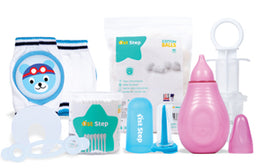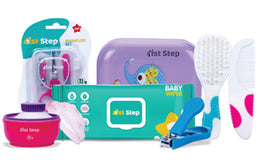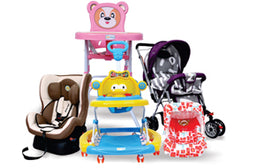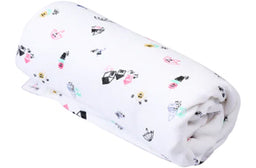How To Wash Reusable Diapers: Tips For Beginner Moms
While cloth diapers can seem like a throwback to the bygone era, they have long made their way to the current baby care industry, with new moms choosing to go cloth for both environmental and financial reasons.
While baby reusable diapers offer multiple benefits, washing them regularly can feel challenging, especially when your days are filled with baby snuggles and sleepless nights. As new moms, we just want to ensure we're doing everything right for our baby, right?
This blog will walk you through everything you need to know to keep those cloth diapers fresh and clean with simple, easy-to-follow steps. We'll break down the washing routine, from pre-treating the diaper to using the right detergent and water temperature.
By the end, you'll feel confident dealing with all sorts of cloth diapers like a pro, making sure your baby feels safe and comfortable at all times!
Are you ready to learn more about cloth diapers and how to tackle them? Let’s get started!
Why Use Cloth Diapers?
There are several compelling reasons why many parents are switching to cloth diapers.
- For one, cloth diapers are much more environmentally friendly than disposables. They produce far less waste that ends up in landfills.
- Financially, cloth diapering saves significantly over time. While there is an upfront cost to purchasing a cloth diapering system, it pays for itself within the first year. Disposable diapers add up quickly at a cost of around Rs.40,000 per baby from birth to potty training.
In comparison, cloth diapers last for years; the only ongoing costs are detergent and occasional replacements.
- Cloth diapers are also healthier for sensitive skin. They don't contain the dyes, fragrances or chemicals found in disposables that can irritate delicate skin. The natural fibres keep babies drier and more comfortable.
Overall, cloth diapers provide environmental, financial and health benefits that appeal to many modern parents.
Pre-wash Checklist
A prewash checklist for cloth diapers helps ensure you properly prepare them for the main wash. Here's a handy prewash checklist you can use:
- Gather all dirty diapers, inserts, and covers from the diaper pail or hamper. Make sure to check pockets and flaps thoroughly for any hidden solids.
- Shake, scrape, or rinse off any solid waste into the toilet. Consider using a diaper sprayer for easy removal.
- Separate different types of diapers, such as cotton, bamboo, or microfiber, as some materials may require different washing conditions.
- Check elastics and snaps on covers and pockets to ensure they are still in good condition. Replace any worn elastics.
- Pre-treat any visible stains by dabbing or spraying directly on the stain. Let sit 5-10 minutes before washing. Common pre-treaters for cloth diapers include baking soda paste, OxiClean, or grout cleaner.
- Avoid overloading the washing machine. Load diapers loosely to allow for proper agitation and cleaning.
- Select a prewash cycle with warm water to help effectively remove initial stains and soils.
- Initiate the prewash cycle to give the diapers an initial cleaning.
Keep these points in mind when you set out to wash your baby’s cloth diapers next time!
Step-by-step Guide To Wash Cloth Diapers
Now that your prep work is done, it’s time to wash the diapers to make sure they’re fit for reuse!
Step 1: Start by running a hot cycle on your washing machine

Once the prewash is done with cold water and no detergent, it's time for the main wash. Use a regular warm to very hot wash cycle with a cloth diaper-friendly detergent.
Step 2: Add extra cleaning agents, if necessary

Feel free to boost the detergent's efficacy by adding a little scoop of baking soda. The baking soda will eliminate protein-based stains and neutralise acidic odours. You can also try adding 1/2 cup of lemon juice if you need to whiten the fabric.
Pro tip: Your baby will use 8 to 10 diapers daily (newborns use more than this). This requires two times as many cloth diapers as you would need per day. Make sure you do not wash more than 12 -18 cloth diapers at once.
Step 3: Double rinse, if necessary

Use the extra rinse setting if it's available on your machine. The more water runs through your nappy, the more clean it is. Double rinsing your cloth diaper also gets rid of any detergent residue. You can use warm or cold water for this extra spin!
That's it, just three steps, and it's time to dry the diapers!
How To Dry Them After Washing?
Drying cloth diapers properly helps maintain their quality and effectiveness. Here's how to do it:
1. Line Drying
The sun is your best friend. Hang cloth diapers in direct sunshine whenever possible. The UV rays from the sun help bleach and disinfect the diapers, eliminating stains and odours.
2. Air Drying
If drying outside is not an option, pick a well-ventilated indoor area. Hang diapers on a drying rack or clothesline indoors and maintain adequate airflow to avoid mildew and smells.
3. Avoid High Heat
While a dryer on low heat can be used occasionally, excessive heat might harm diaper materials like baby elastics and waterproof layers.
4. Separate Inserts
If your diapers have removable inserts or liners, consider drying them separately. Inserts tend to dry faster than diaper covers.
5. Make Sure To Check The Manufacturer’s Guidelines
Always follow the manufacturer's instructions for drying, as specific diaper brands may have unique recommendations.
6. Maintain Them Regularly
Watch out for your diaper inserts and covers. Closures made of elastic and hook-and-loop may break with time. If necessary, replace damaged parts to keep diapers functioning well.
Drying your cloth diapers properly is important to ensure that they remain fresh and effective for your child.
Remember that sunlight is a natural sanitiser and stain remover, making it an excellent choice when drying cloth diapers whenever possible.
DOs and DON’Ts of Washing Cloth Diapers
Here are some DOs and DON’Ts to keep in mind when washing cloth diapers:
| DOs | DON’Ts |
| ● To remove any residue from the cloth diaper, pre-rinse it in the toilet or use a diaper sprayer. ● If using pocket diapers or all-in-ones, separate inserts from covers before washing. ● Run a warm pre-wash cycle to remove initial stains and soil. ● Sanitise your washing machine monthly for the best results. ● Choose a detergent specifically designed for cloth diapers. |
● Fabric softeners can reduce absorbency and cause buildup; avoid using them. ● Avoid bleach and harsh stain removers, as they can damage cloth diaper fabrics. ● Avoid using the dryer since its high heat can damage elastic and waterproof materials. ● Avoid storing wet diapers for extended periods. ● Cloth diapers should be washed separately from regular laundry. |
How Often Should You Wash Your Baby’s Cloth Diapers?
Most experts recommend washing cloth diapers after every 1-2 uses or whenever they become soiled. This frequent washing is important to sanitise the diapers and prevent bacteria buildup. They can also hold onto unpleasant odours, making them non-reusable in the future!
For newborn babies who soil their diapers up to 12 times per day, you will likely need to wash them after every diaper change.
The fastest way to ruin a set of cloth diapers is to keep soiled diapers in the diaper pail for too long. Be sure to keep your laundry schedule on track if you want it to last as long as possible!
Proper and frequent cleaning is essential for cloth diaper hygiene and your baby's comfort.
Get Safe and Comfortable Reusable Diapers at 1st Step!
As we know by now, cloth diapers provide a soft, breathable environment that is gentle on a baby's delicate skin. As new moms, it’s your responsibility to keep them clean and fresh, ensuring the best for your little one.
At 1st Step, we have a wide range of safe, chemical-free and adjustable cloth diapers, specifically designed to make your baby feel clean and comfortable at all times. Apart from diapers, we also offer a huge selection of other baby care products that ensure maximum safety and comfort for your baby.
From feeding and nursing to grooming and baby gear, choose from A-Z baby products at 1st Step!
Conclusion
Whether you're motivated by cost savings, reducing waste or simply enjoying the convenience, we hope this blog post leaves you feeling confident in keeping those reusable diapers fresh and clean for your little one!
With the simple steps outlined in this guide, you are now fully equipped to wash your cloth diapers like a pro! Remember that cloth diapering gets easier with time as you fall into a routine. And, of course, be sure to share your favourite tips with other new moms just starting their cloth diapering journey.
Frequently Asked Questions (FAQs)
1. How do you wash new cloth diapers for the first time?
Cloth diapers with natural fabrics should be washed with hot water with the prescribed amount of cloth diaper detergent and dried afterwards.
2. How many times should you wash cloth diapers before first use?
To get rid of the natural oils that make up the plant fibres, natural, unbleached prefolds must be washed at least four times prior to use.
3. Can cloth diapers last all night?
Yes, cloth diapers can last overnight. But it also depends on the absorbency. Most newborns can manage just well with ordinary absorbency; while most require an extra insert at night.
4. Can we use cloth diapers daily?
Yes, you most certainly can! However, be mindful of the number of changes you will need to make daily. Older infants and toddlers might need 8 to 10 changes per day, whereas an average newborn needs 10 to 12 changes every day.
5. How long can a cloth diaper last?
The average lifespan of cloth diapers is somewhere between 10 months and 20 months of continuous use with variation. However, if you use strong chemicals or are hard on them, they will typically last for no longer than 6-8 months.
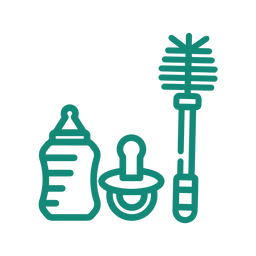 Feeding & Nursing
Feeding & Nursing Safety & Grooming
Safety & Grooming  Bathing & Diapering
Bathing & Diapering Baby Gear
Baby Gear Mother Needs
Mother Needs Muslin Essentials
Muslin Essentials Baby Toys
Baby Toys



